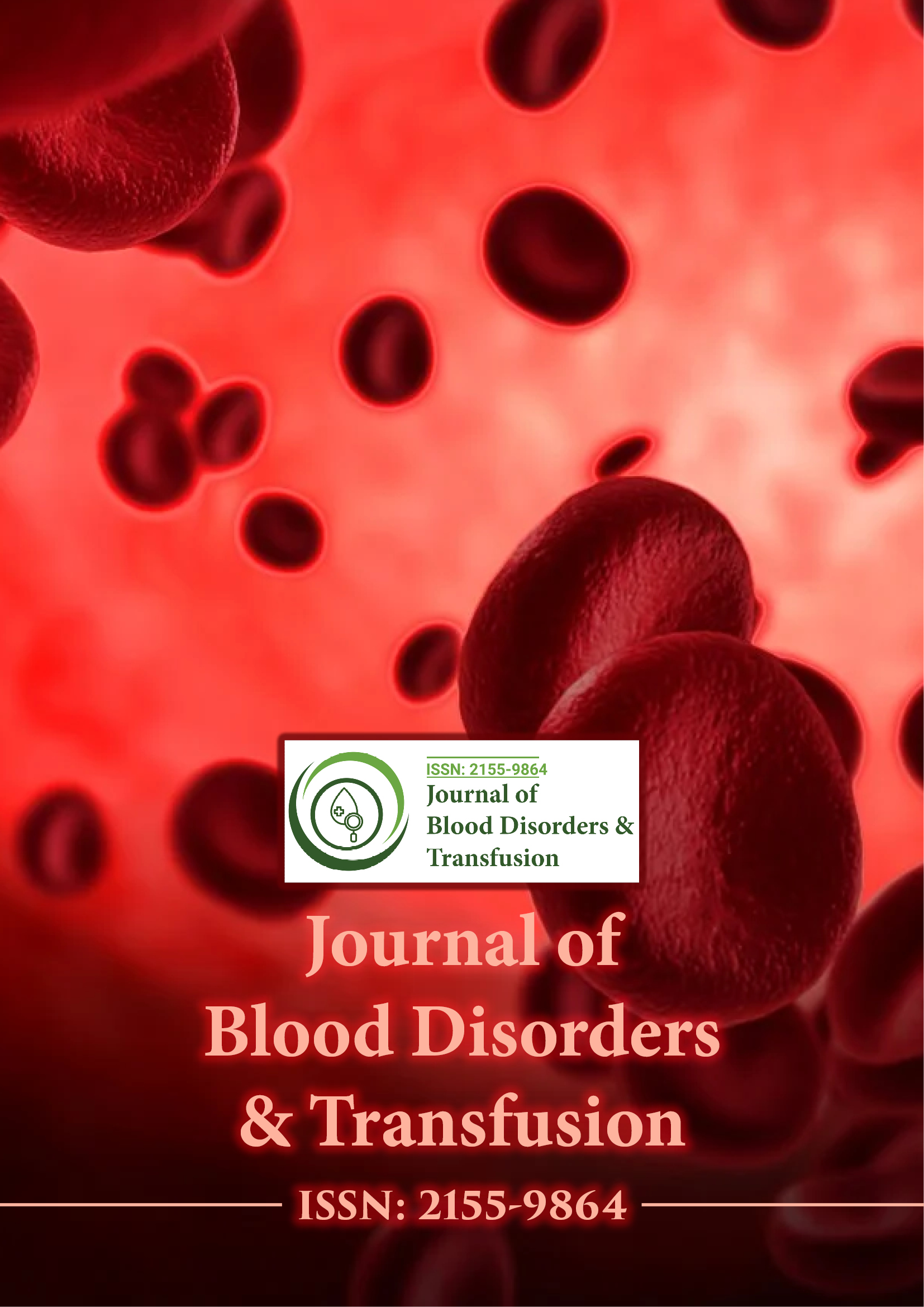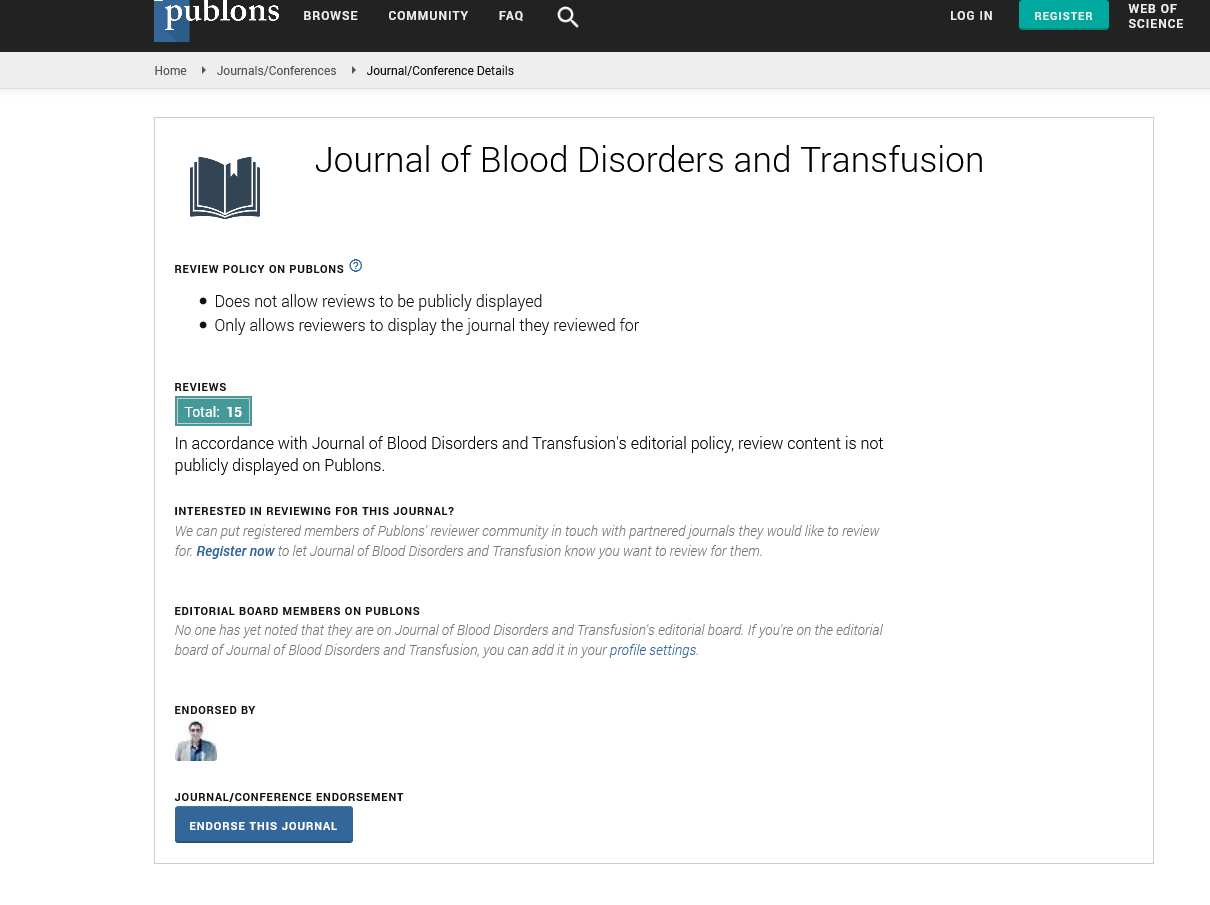Indexed In
- Open J Gate
- Genamics JournalSeek
- JournalTOCs
- Ulrich's Periodicals Directory
- RefSeek
- Hamdard University
- EBSCO A-Z
- OCLC- WorldCat
- Proquest Summons
- Publons
- Geneva Foundation for Medical Education and Research
- Euro Pub
- Google Scholar
Useful Links
Share This Page
Journal Flyer

Open Access Journals
- Agri and Aquaculture
- Biochemistry
- Bioinformatics & Systems Biology
- Business & Management
- Chemistry
- Clinical Sciences
- Engineering
- Food & Nutrition
- General Science
- Genetics & Molecular Biology
- Immunology & Microbiology
- Medical Sciences
- Neuroscience & Psychology
- Nursing & Health Care
- Pharmaceutical Sciences
Commentary Article - (2021) Volume 12, Issue 9
Transfusion of Platelets
Gordon Heal*Received: 01-Oct-2021 Published: 22-Oct-2021
Introduction
Platelet bonding, otherwise called platelet concentrate, is utilized to forestall or treat draining in individuals with either a low platelet check or helpless platelet work. Regularly this happens in individuals getting disease chemotherapy. Holding of platelets is an every so often applied and regularly life-saving procedure, used for both prophylactic and remedial signs. Over the span of the latest numerous years, distinctive natural limits have been credited to platelets, and platelet holding research has acquired immense ground too [1] . This issue of Transfusion Medicine Reviews is focused on late degrees of progress in platelet research with a particular focus on holding related focuses. Perhaps the most recognized components of platelets past their critical obligation to fundamental haemostasis is their congruity as immune cells in both normal and flexible obstruction [2,3]. A progressive issue experienced in the treatment of thrombocytopenic patients is the shortfall of an adequate check increment following holding. This habitually disillusioning experience is most commonly because of non-immunologic causes. Throughout the last 50 years, platelet bonding has been a successful treatment for the counteraction and treatment of dying, especially in patients with hematologic malignancies. Ongoing randomized preliminaries have shown that current practices might be problematic in various manners [4,5,6] . The reasoning for stinginess in the utilization of this amazing treatment incorporates recently portrayed extreme and lethal antagonistic results, recently depicted genuine likely dangers, trouble in keeping up with satisfactory supplies of platelets, the need to put volunteer givers on cell separators to give the item, and cost. Draining is a somewhat remarkable reason for death in non-injury patients however can be a huge grim occasion to say the least and, best case scenario, very disturbing for patients, families, and suppliers. Along these lines, generally, with the view that platelet bonding is basically favourable, the driving force has been to bond platelets forcefully to forestall as opposed to treat dying. There are two kinds of platelet items for bonding. Entire blood platelets, which are gotten from four to five entire blood gifts, pooled, leukoreduced, bacterially tried, and lighted, used to be the standard bonding item. Apheresis platelets got from givers who put a few hours on a cell separator have become the most generally utilized item in the US. Patients getting pheresis platelets are probably going to have a higher danger of hemolytic responses and of intense lung injury due to having bigger measures of plasma from a solitary contributor, yet convey a lower hazard of irresistible sickness transmission because of less giver openings. Prior investigations have shown that permit vaccination and stubbornness to bonding are normal in beneficiaries of non- leukoreduced b ondings [7,8]. Hence, nearly everybody concurs that platelet bonding ought to consistently be leukoreduced. For patients who have extreme or rehashed fever, afflictions, or unfavourably susceptible or aspiratory complexities with bonding, saline-washed platelets are accessible in certain emergency clinics. These need around 2 hours of extra planning time and contain about 20% less platelets than unwashed platelets. One investigation recommends that clinical results are improved with the utilization of washed platelets in grown-up patients with intense leukaemia and that post-bonding fever, afflictions, and urticarial can be totally destroyed [9,10].
REFERENCES
- Brand A, Novotny V, Tomson B. Platelet transfusion therapy: from 1973 to 2005. Hum Immunol. 2006; 67: 413–418.
- Slichter SJ. Platelet transfusion therapy. Hematol Oncol Clin North Am. 2007; 21: 697–729.
- Heal JM, Blumberg N. Optimizing platelet transfusion therapy. Blood Rev. 2004; 18: 149–165.
- Slichter SJ. Background, rationale, and design of a clinical trial to assess the effects of platelet dose on bleeding risk in thrombocytopenic patients. J Clin Apher. 2006; 21: 78–84.
- Sadani DT, Urbaniak SJ, Bruce M, Tighe JE. Repeat ABO- incompatible platelet transfusions leading to haemolytic transfusion reaction. Transfus Med. 2006; 16: 375–379.
- Sapatnekar S, Sharma G, Downes KA, Wiersma S, McGrath C, Yomtovian R. Acute hemolytic transfusion reaction in a pediatric patient following transfusion of apheresis platelets. J Clin Apher. 2005; 20: 225–229.
- Josephson CD, Mullis NC, Van Demark C, Hillyer CD. Significant numbers of apheresis-derived group O platelet units have “high-titer” anti-A/A,B: implications for transfusion policy. Transfusion. 2004; 44: 805–8.
- The Trial to Reduce Alloimmunization to Platelets Study Group Leukocyte reduction and ultraviolet B irradiation of platelets to prevent alloimmunization and refractoriness to platelet transfusions. N Engl J Med. 1997; 337: 1861–1869.
- Heal JM, Rowe JM, McMican A, Masel D, Finke C, Blumberg N. The role of ABO matching in platelet transfusion. Eur J Haematol. 1993; 50: 110–7.
- Vo TD, Cowles J, Heal JM, Blumberg N. Platelet washing to prevent recurrent febrile reactions to leucocyte-reduced transfusions. Transfus Med. 2001; 11: 45–7.
Citation: Heal G (2021) Transfusion of Platelets. J Blood Disord Transfus 12: 483
Copyright: © 2021 Heal G. This is an open-access article distributed under the terms of the Creative Commons Attribution License, which permits unrestricted use, distribution, and reproduction in any medium, provided the original author and source are credited.

